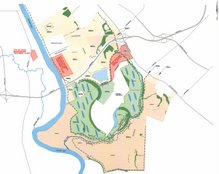- The effluent that is currently discharged into the Congaree River would instead be sent to the Columbia Wetlands for tertiary treatment to remove additional nutrients and toxins, resulting in cleaner wastewater and no additional odors.
- The Columbia Wetlands will allow the Metro plant to meet stricter effluent limits which will be applied to the plant (1) when it expands or (2) when DHEC completes a total maximum daily load (TMDL) study of the Congaree River or (3) when DHEC completes a wasteload allocation for the relevant watersheds.
- The capital and operating costs of constructed wetlands are a fraction of traditional wastewater treatment costs.
- Constructed wetland cells have an expected life cycle 20 - 30 years which may be extended with proper maintenance and operation, and can be continually renewed by “de-mucking” the wetlands, or removing the dead plant biomass and replanting the wetlands.
- Constructed wetlands are environmentally friendly and often serve as nature parks and research facilities:
- 40,000 visitors per year to the Augusta, GA wetlands
- 12,000 visitors per year to the Orlando, FL wetlands
- Constructed wetlands are a time proven solution:
- The following cities are developing constructed wetlands:
- West Palm Beach, FL (1600 acres)
- Chicago, IL
- Phoenix, AZ (1500 AC)
- New Orleans, LA
- Independence, MO
- Here is a list of 15 constructed wetlands in Florida, including the world’s largest CTW (16,500 acres) in the Florida Everglades.
Wednesday, January 31, 2007
Benefits of Constructed Wetlands
Subscribe to:
Post Comments (Atom)

No comments:
Post a Comment